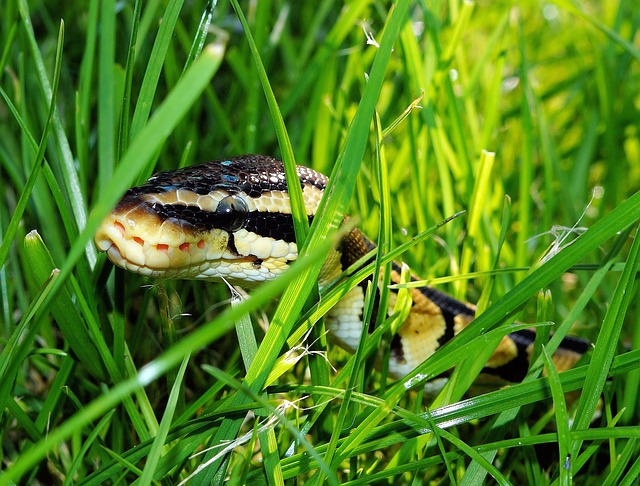
Photo via Pixabay
Unexpectedly crossing paths with a snake in your own yard — or worse, inside your house! — is an unnerving thought for many homeowners. Fearing snakes is quite common, and that might be a reason they seem so mysterious to many of us. After all, it’s tough to make yourself research something that scares you! But being able to decipher a dangerous serpent from a harmless one can not only help you keep your family safe, it can also be a fascinating learning opportunity.
This guide will cover the key factors to consider when observing and potentially removing snakes from your home. First, you’ll need to know the kinds of traits to look for to determine whether a snake is hazardous. Next, it’s important to learn the habitats and hiding spots in which you might stumble upon these legless creatures. Finally, you’ll want to learn safe, humane options for removing any problem snakes from your property — whether you encounter one inside or out.
The more prepared you are for a snake encounter, the less panicked you’ll feel in the moment and the quicker you’ll be able to react appropriately. Fears pushed aside, safe snake-observing starts here!
Friend or Foe: How to Identify Dangerous Snakes from Harmless Ones
Keep in mind that of the 120 species of snakes found across North America, only 20 pose a deadly threat to humans and domestic animals. It’s crucial to find out which ones have been spotted in your area, so talk to your neighbors and consult animal control, as well. Do take note that just because no one’s ever seen a venomous snake around or there aren’t any native to your area, it’s always better to err on the side of caution if you see one — especially if it has the traits of a dangerous species.
So what should you look for? There are a few key characteristics to keep an eye on: the snake’s body type, head shape, eye characteristics, tail, and coloring. Remember: keep a safe distance before approaching any snake you come across. Even if you’ve seen a garden snake slither through your backyard a dozen times, each new encounter should be treated with caution. Additionally, having a field guide handy — be it a pocket hardcopy or online — is always a good idea.
Starting general by identifying the body type is not only the safe place to start, it’s both the smartest and simplest. Consider the snake’s body: is it short, long, or something in-between? Is it somewhat fat the entire length of its body, or slim and skinny? Depending on the species, snakes can grow anywhere from around a foot to several meters long, so keep it relative. If you’re having trouble deciding on the appropriate size category, make an estimation of how long it appears to be: two feet? Less than five feet? Or perhaps you do better thinking in terms of comparison: was the snake fatter than a garden hose, or about the same diameter? Your measurements don’t have to be exact, but getting a general sense can make it easier for you or a professional to identify what you’re dealing with.
Next, you’ll need to consider the snake’s head shape, typically categorized as oval, arrowhead, or spade-shaped. Generally, snakes with a more triangular shape to their heads are dangerous, but looks can be deceiving: for instance, the head of the deadly coral snake is oval. Further, some non-venomous snakes might flatten their heads if they feel threatened or anxious, making them appear to be a more dangerous species at a glance. There’s a common misconception that head shape alone can identify a venomous snake, but it’s only a single aspect to consider.
While observing the head, take note of the eyes. Are they large and obvious, or somewhat small? Are the pupils vertical (similar to a cat’s) or round? Vertical pupils indicate the snake may be mostly nocturnal, and many (but not all) with this trait are venomous. You should also take note of the location of the eyes on the head, their size, and color. If the creature you see has moveable eyelids, it’s probably a legless lizard since snakes only have a clear “spectacle” scale protecting their eyes. Some snakes do have scales that jut over the eyes like an eyebrow, making the creature appear even more nefarious. These species do tend to be more dangerous — if the snake actually looks like it’s glaring at you, increase your distance!
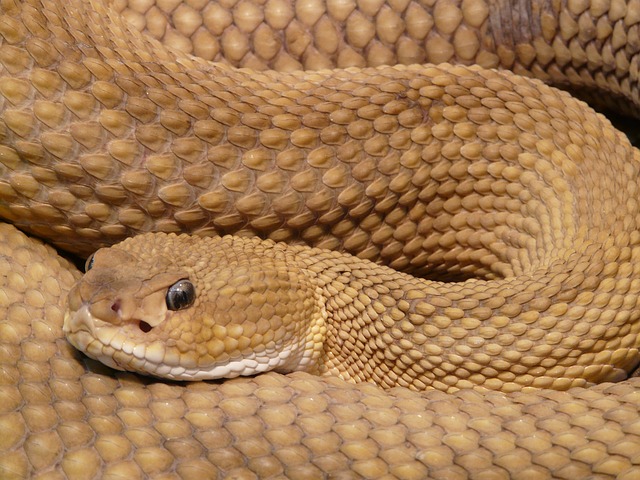
Photo via Pixabay
The coloring and patterns of a snake’s skin are also important indicators of its potential danger. There are a few different categories of patterns:
- Stripes — lines of color running lengthwise down the body
- Rings — bands of color that stretch across the back, down the sides, and around the belly
- Crossbands — bands of color stretching across the back and down the sides of the body, but do not cross the snake’s belly
- Spots — small, rounded marks that may cover several scales; typically don’t have borders, and may cover several scales
- Speckles — very small, fleck-like dots of color; more than one may appear on a single scale
- Blotches — large, random color blocks that are often rectangular in shape; often have borders
- Diamonds — large, diamond-shaped markings of one or multiple colors
Your field guide may instruct you to take special note of the location of certain kinds of markings, but remember to only do so from a safe distance. Not every snake will have unique markings. In fact, several species are a single, solid color, while others might be one color on their back and another on their belly.
Finally, a snake’s tail can also be a clue to its species. You might not be able to tell exactly where the tail begins at a distance, so pay attention to its tip. Is it pointed or rounded? Does it have any special pattern or markings on it? And, of course, does it have a rattle? Rattlesnakes can be especially dangerous, especially if they feel threatened, so the moment you see or hear a rattle is the moment to call for professional assistance!
Unexpected House Guests: Where Might You Encounter a Snake at Home?
Knowing where a snake might be hiding around your home can make them less likely to catch you by surprise and teach you which spots your family should be wary of. Your home’s location and proximity to bodies of water, wooded areas, fields, or swamplands may increase your likelihood of seeing a serpent, but they can be found in nearly every kind of environment. Be sure to find out what your area might be at risk for, and relay the warnings to your children.
Snakes like to take cover when they can, so areas where there are lots of rocks or logs are a common hiding spot. However, it doesn’t have to be natural cover, and many snakes will seek shelter under manmade materials like fallen siding, under and around gutters or retaining walls, or beneath a building’s foundation. They can even pop up under piles of cut grass, raked leaves, or firewood. Always approach areas like this cautiously, doing what you can to make your presence known to avoid spooking the snake into aggressive defense. Stomp or shuffle your feet, and create noise by talking loudly or clapping to warn of your approach.
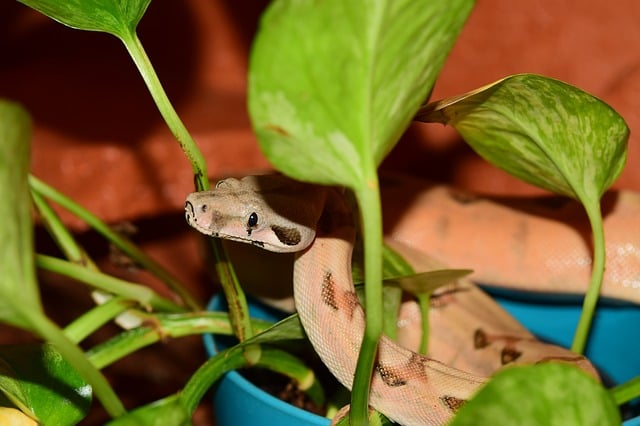
Photo via Pixabay
If they can’t find a meadow or field, snakes will often settle for what’s convenient cover. An overgrown backyard can be a great home not only for snakes, but for the rodents and small animals they prey on. Chicken coops or other outdoor animal pens will also be inviting, especially if there are grassy areas around.
Some snakes are blind and/or nocturnal, so they’ll prefer areas with low light. Basements, cellars, or storm shelters can make for excellent cover, and even better if they can find rodents nearby. Large snakes might even be able to lift a closed but unlocked door themselves, and smaller species can often fit into a tight space or opening to gain entry.
These impressive entries can also occur if a snake deems your home to be inviting — it may be attempting to escape cold weather, find food, or even find a safe place to lay eggs. Keep this in mind if a snake does enter your house: it was likely looking for food or shelter with little intention of causing you or your family harm. It’s still a wild animal that should be handled with care, but reminding yourself that its intentions were originally pure can help allay the stress of removing it.
Snake Control: Safe and Humane Serpent Prevention and Removal
If you’re looking to reduce your likelihood of seeing snakes around the home, it’s important to take proper prevention steps. It essentially comes down to eliminating the potential sources of food and shelter that make your home seem appealing to these creatures. Some regions of the country might see a greater snake presence in general, making it tricky to completely eradicate their presence in your neighborhood, but a few small modifications can go a long way in keeping them out of the house.
Eliminating a snake’s food sources means also eliminating their prey’s food sources. Make sure any animal feed, whether inside or out, is kept in airtight containers. Avoid leaving out large open bowls of food for pets, opting instead to feed them at certain windows throughout the day. If you keep any produce or crops that you harvest, make sure their storage is kept tightly secured and check containers thoroughly for holes or cracks. Storage sheds where these kinds of items are kept should also be assessed for damage and possible pest entry points. If you have a chicken coop, make sure it is secured against predators of any size, including snakes. You should also take steps to make it rodent-proof, cleaning up any stray pieces of corn or feed to keep it relatively tidy and less attractive to hungry mice and rats.
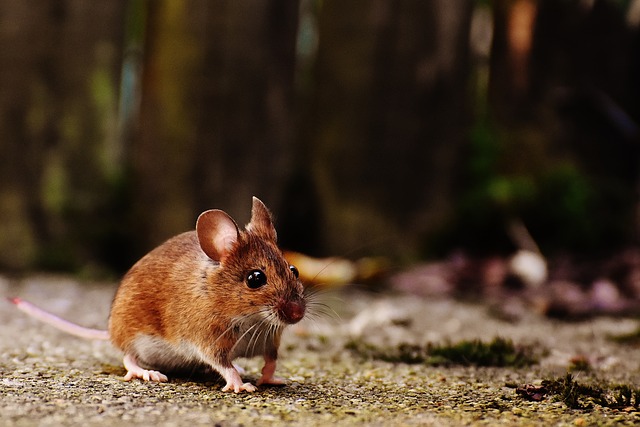
Photo via Pixabay
When it comes to ridding your property of potential snake habitats, much comes down to basic maintenance. Keep your lawn trimmed and use a weed whacker to cut back the particularly grassy areas around corners, decks, stairs, and storm cellars. Store piles of wood, roofing supplies, sheet metal, and any other large materials that could provide clandestine housing in the garage or shed. If you’re working on a project that requires these materials and storing them overnight simply isn’t a viable option, approach your supplies with caution when you return to work.
If you’re considering adding a pond to your yard, you’ll want to plan to install it at a good distance from your house, and not too close to areas where your children might play. Some species of snakes prefer to eat frogs, so finding a location with food, water, and likely, many rocks or shady spots to hide would be ideal for them. Remember: just because you haven’t seen a snake yet doesn’t mean they aren’t around, so plan your pond as if you know it will attract both amphibian prey and predator serpents.
If a snake has made its way into your house, the first step is to remain calm. Keep children and pets far away, especially younglings that may be overcome by their curiosity and not realize the danger. If there’s an exterior door nearby that you can reach safely, prop it open. Snap a few photos of the snake — don’t get too close; the zoom function is your friend! — or take notes on the characteristics you’re able to identify. Even if you end up being able to remove a harmless snake yourself, it’s helpful to be able to keep track of exactly which ones you’ve seen in the area.
If your observations and field guide have confirmed it’s a harmless garden snake, you can use a broom or mat to brush and direct the creature out an exterior door. Approach it slowly and quietly, taking care not to startle it or sneak up on it. If you’re feeling bold in light of a harmless snake, it might be simpler to put on gloves and carry the snake out yourself, or to place it in a pillowcase and release it outside. Just make sure you’re absolutely certain it isn’t venomous, and be prepared for it to behave somewhat erratically out of fear. If it’s coiled and refusing to budge, you can place a bucket or small trash can over the snake, then slide a thin, sturdy mat underneath. You can slowly lift the makeshift trap and release the snake outside, or weigh the bucket down until help arrives.
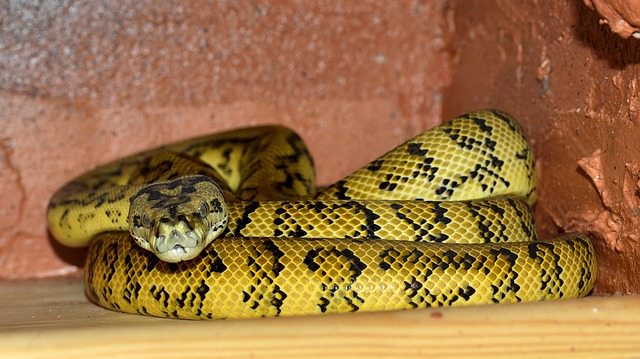
Photo via Pixabay
If you’re unable to remove the snake yourself for any reason, do what you can to make it simple for animal control to retrieve the animal. Close off the room it’s in or barricade it into a corner if you can do so without getting too close. A towel under the door can prevent it from sliding underneath, though you’ll want to make sure it’s packed tightly enough to resist if the snake tries to push through. If the snake is constantly lashing out and moves quickly, it’s best to leave it completely alone to avoid injury. Consider waiting for animal control at a neighbor’s house, and be prepared to answer questions from the technician about what you saw.
If snakes have become a recurring problem on your property, there are humane traps you can set that will safely capture and contain a snake. Glueboards tend to be one of the most effective methods, are low-cost, and can easily be made from a piece of wood and some rodent glue traps. They can be placed in sheds, basements, crawl spaces, or anywhere else you’ve seen a snake or think they might be hiding. Check them regularly to make sure you can immediately release what you’ve caught, using olive oil to free them from the glue once you’re outside. One-way snake doors are another excellent option, though you’ll want to remove them seasonally.
Snakes are certainly intimidating animals, but when it comes to your home, it’s important to take charge. Do what you can to prevent their presence on your property, but keep in mind that there are actually some snakes that can be beneficial to have around. Garden snakes, for example, can help keep away voles, mice, and other rodents that might be munching on the fruits of your labor. Make the experience a learning opportunity, especially if you have children, and embrace the chance to learn more about these often-misunderstood creatures.
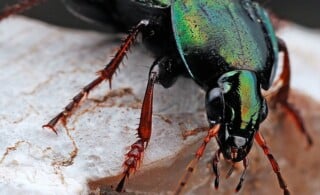 A Homeowner’s Guide to Entomology and House Insects
A Homeowner’s Guide to Entomology and House Insects 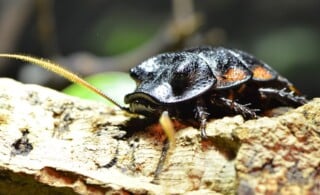 Roach Control the Natural Way
Roach Control the Natural Way  Getting Rid of Raccoons: Problems and Solutions
Getting Rid of Raccoons: Problems and Solutions  Flea Control & Prevention
Flea Control & Prevention  An Eco-Friendly Yard: How to Keep Bugs, Weeds, and Other Nuisances Out Without Harming the Planet
An Eco-Friendly Yard: How to Keep Bugs, Weeds, and Other Nuisances Out Without Harming the Planet 

I am living in a non plasterd room.Can u brief me about old non-plasterd walls hazards like snakes,insect or dust hazard?